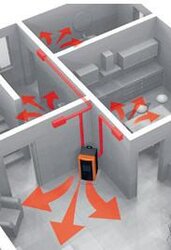Hello all!
After making it through a cold winter in a 2700 or so square foot house, 25 foot cathedral ceilings, poor insulation and only a fireplace insert until january, I'm ready to take the plunge and buy a furnace. First, this is my first home and I was unprepared for the cost of propane in my area, at over $3 a gallon, I have a 1000 gallon tank, and I filled it in january and started using it. It was gone, keeping my house at 68 degrees, in right about two months. I'm sitting on 300 gallons now.
In August I will commission as a 2LT in the Army guard, and will also get a chunk of change from my bank, which I intend to use part of it for home improvement.
I'm going to insulate my whole house (double insulating it), which will bring it basically to code. This winter I threw 4 rolls of insulation in my attic in areas that were uninsulated alone, above my living room. It cut my propane furnace run time to 12 hours a day from 14, almost immediately.
Second, I'm going to buy a new propane furnace. Mine is 10 years old at 90% efficient. I'm considering a modulating 98% efficient module. I'm also going to buy either a wood furnace or a pellet furnace. I'm set on two things for now. I want them to be indoors, and I want them to be "forced air" models. id they work right into my existing forced air easily.
Lastly, my HVAC guy basically told me that the duct work coming off my furnace is set up about as inefficient as possible and explains why i can barely feel air out of some of my vents upstairs.
Does anyone have any general advice or tips on any of the above?
Does anyone have recommendations, on models, of wood, pellet, or propane furnaces? Setups tips? anything?
I'm on my own here, and I'd like some sage advice. Currently if I ran my propane furnace only and kept my house at 69 degrees, it'd cost me over 6k a year to heat. No deal!
Chris
After making it through a cold winter in a 2700 or so square foot house, 25 foot cathedral ceilings, poor insulation and only a fireplace insert until january, I'm ready to take the plunge and buy a furnace. First, this is my first home and I was unprepared for the cost of propane in my area, at over $3 a gallon, I have a 1000 gallon tank, and I filled it in january and started using it. It was gone, keeping my house at 68 degrees, in right about two months. I'm sitting on 300 gallons now.
In August I will commission as a 2LT in the Army guard, and will also get a chunk of change from my bank, which I intend to use part of it for home improvement.
I'm going to insulate my whole house (double insulating it), which will bring it basically to code. This winter I threw 4 rolls of insulation in my attic in areas that were uninsulated alone, above my living room. It cut my propane furnace run time to 12 hours a day from 14, almost immediately.
Second, I'm going to buy a new propane furnace. Mine is 10 years old at 90% efficient. I'm considering a modulating 98% efficient module. I'm also going to buy either a wood furnace or a pellet furnace. I'm set on two things for now. I want them to be indoors, and I want them to be "forced air" models. id they work right into my existing forced air easily.
Lastly, my HVAC guy basically told me that the duct work coming off my furnace is set up about as inefficient as possible and explains why i can barely feel air out of some of my vents upstairs.
Does anyone have any general advice or tips on any of the above?
Does anyone have recommendations, on models, of wood, pellet, or propane furnaces? Setups tips? anything?
I'm on my own here, and I'd like some sage advice. Currently if I ran my propane furnace only and kept my house at 69 degrees, it'd cost me over 6k a year to heat. No deal!
Chris


 Good like and keep us posted on what you decide!
Good like and keep us posted on what you decide!